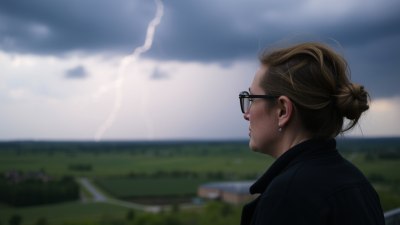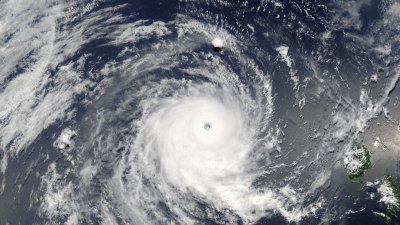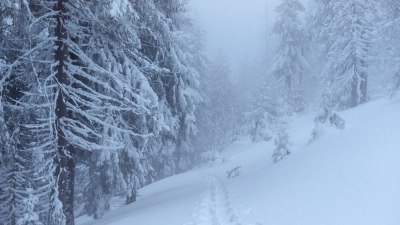Why the Forecast Shapes More Than the Day
Explore how weather forecasts influence decisions, behaviors, and perceptions beyond just daily weather, shaping culture and planning.

Image by ruslanbatiuk on Freepik
Weather forecasts have long been an integral part of human society, influencing a myriad of activities and decisions that extend far beyond the simple expectation of rain or sunshine for a given day. While the immediate purpose of a forecast is to inform people about the weather conditions they will face today or tomorrow, its impact permeates many layers of our daily lives, shaping behaviors, economic activities, social interactions, and even cultural outlooks. This article explores why the forecast shapes more than just the day itself, delving into the psychological, economic, social, and environmental implications of weather prediction and its role in modern life.
The Psychological Impact of Weather Forecasts
Weather is closely tied to human mood and behavior, making forecasts a significant psychological influencer. Knowledge of forthcoming weather conditions affects how people plan their activities, manage their expectations, and regulate their moods. For instance, a forecast predicting a warm, sunny weekend can elevate one’s mood and motivate outdoor activities, whereas a forecast of rain or cold can dampen enthusiasm and prompt a retreat indoors.
Moreover, uncertainty in weather forecasts can generate anxiety or stress for individuals, especially those whose daily routines depend heavily on favorable weather. This psychological aspect reveals how a forecast does not just inform about the environment but also subtly guides emotional preparation for what lies ahead. In some cases, individuals may feel empowered by accurate forecasts that allow them to prepare adequately, while in others, unexpected changes or inaccuracies may lead to frustration or mistrust in meteorological science.
Forecasts and Economic Decisions
Economic activities are among the most impacted by weather forecasts, demonstrating that their influence extends well beyond recreational planning. Agriculture, construction, transportation, energy management, and retail sectors depend heavily on weather information to optimize operations and mitigate risks.
Farmers rely on forecasts to determine planting and harvesting schedules, manage irrigation, and protect crops from adverse conditions. A poor forecast or an unexpected weather event can lead to significant financial losses. Construction managers use weather predictions to schedule work in a way that maximizes safety and efficiency, avoiding delays or damage caused by weather-related disruptions.
Transportation industries, including airlines, trucking, and shipping, plan routes and schedules according to forecast data to ensure safety and punctuality. Energy companies forecast demand based on temperature patterns and anticipate supply disruptions caused by storms or extreme weather. Retailers may stock seasonal items influenced by forecasted weather trends, adjusting their marketing campaigns accordingly.
Social and Cultural Dimensions of Weather Forecasting
Forecasts influence social behavior and cultural events in ways that are not always obvious but are deeply rooted in societal norms and traditions. Major public events such as festivals, sports games, weddings, and parades often hinge on weather predictions. Organizers use forecasts to decide on event timings, venue arrangements, or contingency plans, ensuring the safety and enjoyment of participants.
Culturally, weather forecasting has shaped folklore, literature, and even art. The anticipation of weather changes has been depicted in stories and poems, symbolizing broader human experiences such as hope, despair, or transformation. In many societies, the accuracy and reliability of forecasts also play a role in trust toward scientific knowledge and government institutions responsible for public communication.
Technological Advancements and Forecast Accessibility
The evolution of technology has dramatically increased the accessibility and precision of weather forecasts, thus amplifying their influence. From the early days of observing clouds and winds to sophisticated satellite imaging and computer modeling, forecasting has become a cornerstone of modern information systems.
Mobile apps, smart devices, and internet connectivity allow people to receive real-time updates tailored to their location and needs. This on-demand accessibility enables dynamic decision-making, from choosing daily outfits to managing sensitive industrial operations. Consequently, the forecast shapes short-term behavior continuously, while also affecting long-term planning strategies.
Advanced forecasting models, incorporating data from various sensors and employing artificial intelligence, have improved the prediction of extreme weather events. This progress enhances community preparedness and disaster management, thereby reducing potential damage and saving lives. Therefore, the forecast transcends the concept of merely shaping the day, contributing fundamentally to resilience and safety at multiple scales.
Environmental and Climate Considerations
In addition to immediate weather conditions, forecasts contribute to understanding broader climate patterns and environmental changes. Seasonal outlooks and long-term climate projections help governments, businesses, and individuals adapt to shifts in weather norms, such as rising temperatures, altered rainfall patterns, and increased frequency of extreme events.
These insights inform policies on water management, urban planning, and conservation efforts, demonstrating that forecasts play a role in sustaining ecosystems and human habitability. Recognizing patterns in local weather data also fosters environmental awareness and encourages sustainable practices among the public.
Education and Public Awareness
Weather forecasts serve an educational function by familiarizing the public with meteorological concepts and the scientific principles behind weather phenomena. The regular communication of forecasts cultivates interest in science and promotes public understanding of natural systems.
This public education aspect empowers people to interpret forecasts critically and make informed decisions. It also supports community engagement in environmental issues, framing weather events within larger conversations about climate and planetary health.
Forecasts as Tools for Risk Management
One of the critical roles of weather forecasting lies in risk management. By providing early warnings about storms, floods, heatwaves, or cold snaps, forecasts enable authorities to prepare for emergencies and communicate safety measures effectively.
Businesses use forecasts to safeguard assets and plan contingencies. Individuals rely on them to adjust activities and protect personal property and health. The aggregation of these responses reduces potential losses and facilitates quicker recoveries from disruptive weather events.
The Social Psychology of Forecast Trust
The extent to which people allow forecasts to influence their behavior depends on trust in forecasting agencies and perceived accuracy. Past experiences, media representation, and cultural attitudes shape this trust, which in turn affects the forecast's power to shape more than just the day's expectations.
In contexts where trust is high, forecasts serve as authoritative guides. Conversely, skepticism may lead to disregard for warnings, increasing vulnerability. Understanding these social dynamics is vital for improving communication strategies and enhancing the positive impacts of forecasting on society.
The Forecast and Daily Life Integration
In everyday life, weather forecasts integrate into routines in subtle yet pervasive ways. Morning rituals often include checking the weather to choose attire, plan commutes, or schedule outdoor activities. This habitual consultation shapes not just the single day but sets the tone for subsequent days and weeks.
With the advent of smart home technologies, forecasts can trigger automated responses, such as adjusting thermostats or scheduling irrigation. This seamless integration underscores how forecasts have become embedded into daily decision-making frameworks, molding experiences consistently.
Economic Forecasts Parallel: A Comparative Insight
Drawing a parallel to economic forecasts helps illustrate the broader implications of weather forecasting. Just as economic projections influence policy, investment, and consumer confidence beyond the present quarter, weather forecasts direct future-oriented behavior affecting economic cycles and societal rhythms.
Both fields depend on data accuracy, modeling expertise, and communication efficacy. They also face challenges in uncertainty management and public perception. Recognizing this parallel highlights the multifaceted nature of forecasting as a tool for navigating an uncertain future.
Adaptive Strategies and the Forecast
Societies develop adaptive strategies in response to forecast information, blending traditional knowledge with modern science. For example, indigenous communities often integrate ancestral weather prediction methods with meteorological forecasts to optimize resource use and cultural ceremonies.
This fusion enhances resilience and demonstrates the forecast's role not just as a scientific output but as a cultural practice shaping identity and survival strategies.
The Ethical Dimensions of Forecasting
Forecasting carries ethical responsibilities related to accuracy, transparency, and communication clarity. Misleading or inaccurate forecasts can cause both economic harm and erode public trust. Ethical forecasting practices involve timely updates, acknowledging uncertainties, and avoiding alarmism.
These principles ensure that forecasts serve the public good and maintain their position as reliable guides for more than just daily weather conditions.
Forecasts and Urban Planning
Urban planners increasingly rely on weather and climate forecasts to design resilient cities. Information about precipitation trends, temperature extremes, and wind patterns informs infrastructure development, drainage systems, and green spaces.
Integrating forecast data into planning helps cities mitigate heat islands, enhance flood protection, and improve public health outcomes. This role situates forecasting as a foundational element in shaping urban environments sustainably over time.
The Forecast’s Role in Tourism and Recreation
Tourism industries respond dynamically to weather forecasts, as visitor decisions often hinge on anticipated weather conditions. Seasonal forecast trends impact the promotion of holiday destinations, the scheduling of tours, and the management of recreational facilities.
Outdoor recreation providers use forecasts to ensure safety and optimal experiences, adjusting offerings based on expected weather. This relationship further illustrates how forecasts shape activities extending well beyond the mere conditions of a single day.
Media and Forecast Dissemination
Media outlets play a crucial role in the distribution and framing of weather forecasts. The manner in which forecasts are presented influences public perception and engagement.
Television, radio, online platforms, and social media have transformed the speed and reach of forecast dissemination, creating a culture of constant weather awareness. However, this also demands responsibility in accurate reporting to avoid misinformation and panic.
Scientific Uncertainty and Public Understanding
While weather forecasting has advanced considerably, inherent uncertainties remain due to the chaotic nature of atmospheric systems. The public’s understanding of these limitations affects how forecasts are received and utilized.
Effective communication about uncertainty, such as probability forecasts and confidence intervals, helps set realistic expectations and supports informed decision-making that factors in risks and contingencies.
The Cultural Symbolism of Weather and Forecasts
Throughout history, weather has held symbolic meanings in culture and mythology, often representing forces of change, renewal, or challenge. Forecasts, as tools that anticipate weather, have come to embody humanity’s attempt to predict and influence fate.
This symbolic dimension reflects how forecasts shape not only tangible actions but also collective narratives and values associated with the environment.
Personal Narratives and Storytelling Around the Forecast
Individuals often embed weather forecasts into personal stories, using them to explain events, attribute meaning, or frame memories. Whether it’s recalling a storm that disrupted a wedding or a sunny day that brightened a reunion, forecasts become reference points in life narratives.
This storytelling aspect highlights how weather forecasts weave into the fabric of human experience beyond immediate meteorological conditions.
The Future of Forecasting and Its Expanding Influence
Looking ahead, the role of forecasts is expected to grow as climate change increases weather variability and extreme events. Innovations such as hyperlocal forecasting, integration with AI, and predictive analytics will deepen the forecast’s influence on decision-making.
As societies adapt to these changes, the forecast’s function as a tool for shaping not only the day but the trajectory of human activities, planning, and resilience will become ever more critical.











